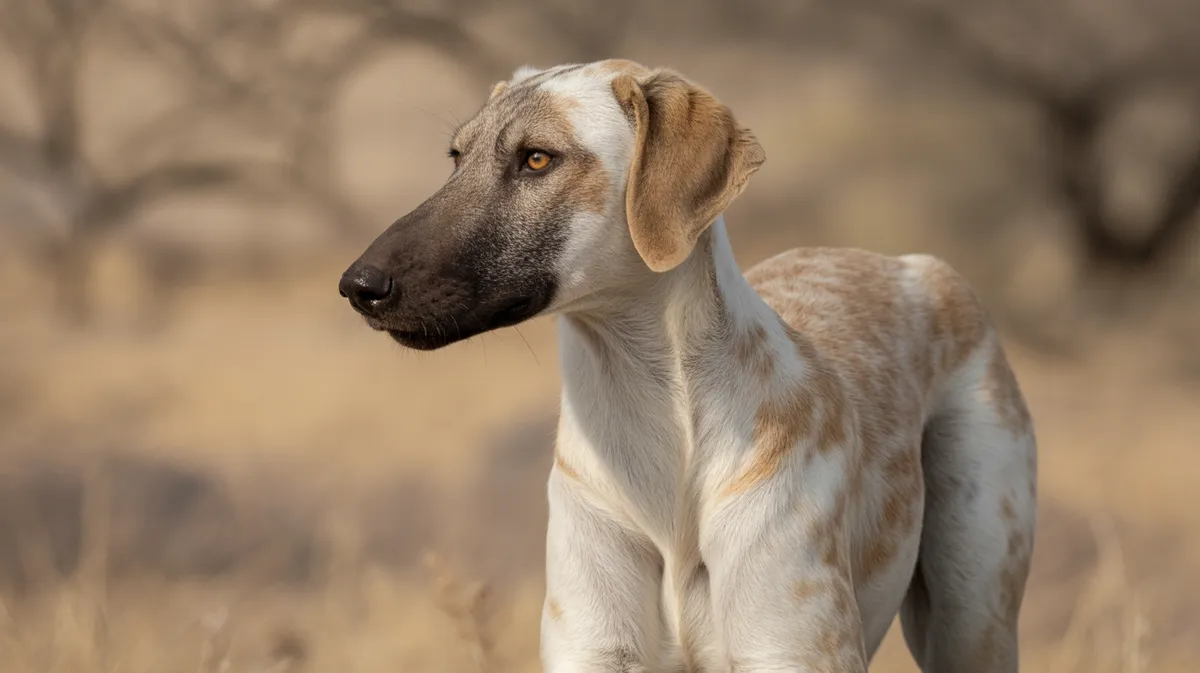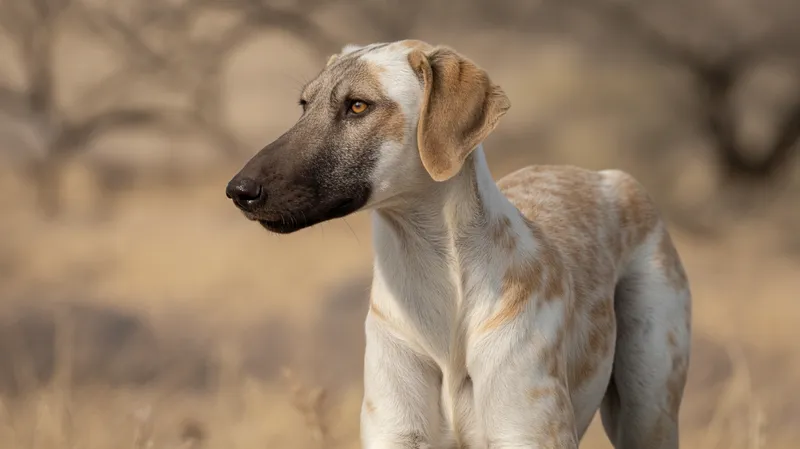
Sloughi
Canis lupus familiaris

Meet the Sloughi
The Sloughi is an ancient sighthound breed native to North Africa, particularly Morocco, Algeria, Tunisia, and Libya. Renowned for its elegant, slender build and remarkable speed, the Sloughi was originally bred by the Berber and Bedouin people for hunting game such as hare, fox, and gazelle across arid landscapes. This breed possesses a gentle, reserved temperament, often forming close bonds with its family while remaining cautious around strangers. The Sloughi's short, smooth coat and keen eyesight make it highly adapted to the harsh desert and grassland environments.
Classification
Mammal
Habitat
Desert and grassland regions
Diet
Carnivore
Lifespan
12-16 years
Conservation
Least Concern
Weight
35-50 lbs (16-23 kg)
📖Fascinating Facts
Desert Specialist
The Sloughi is highly adapted to the extreme temperatures and arid conditions of North African deserts, thanks to its thin coat and efficient metabolism.
Exceptional Eyesight
As a true sighthound, the Sloughi relies on keen vision to spot prey at great distances, making it a prized hunting companion.
Speed and Endurance
Sloughis can reach speeds up to 42 mph (68 km/h) and are built for endurance, enabling them to pursue fast-moving prey over vast stretches of open terrain.
📋Detailed Description
The Sloughi is a medium-to-large sighthound, typically standing 61–72 cm (24–28 in) at the shoulder and weighing between 18–28 kg (40–62 lbs). Its physique is characterized by a lean, muscular frame, deep chest, tucked abdomen, and long, slender limbs, all optimized for sustained speed and agility across open, arid terrain. The breed’s head is elongated and refined, with a slightly domed skull, long muzzle, and dark, expressive eyes that convey a gentle, contemplative demeanor. The coat is uniformly short, smooth, and fine, with colors ranging from light sand to deep mahogany, sometimes with a black mask or brindling. Sloughis possess an exceptional visual acuity, a hallmark of sighthounds, enabling them to detect and pursue fast-moving prey at great distances. Their gait is fluid and effortless, capable of covering vast distances with minimal fatigue. Socially, Sloughis are known for their calm, dignified presence; they are loyal and affectionate with family members but reserved and sometimes aloof with strangers. In their native environment, they are often kept in small groups or pairs, displaying a strong pack instinct and cooperative hunting behavior. The breed’s reproductive cycle is typical of domestic dogs, with females coming into estrus twice a year, and litters averaging 4–6 puppies. Adapted to harsh climates, Sloughis exhibit remarkable endurance, heat tolerance, and a metabolism suited to sporadic feeding, reflecting their origins as desert hunters.
💡 Did you know?
Unlike many sighthounds, the Sloughi has a strong guarding instinct and is often used both as a hunter and a watchdog in its native regions.
🔬Research & Sources
Wikipedia Summary
The Sloughi, or Arabian Greyhound, is an ancient breed of domesticated dog, specifically a member of the sighthound family. It originates from North Africa and is found in Algeria, Tunisia, Morocco and Libya.
Last Modified: 2/10/2025
🎭Behavior & Social Structure
Sloughis are crepuscular by nature, being most active during dawn and dusk when prey is abundant and temperatures are milder. As sighthounds, their hunting strategy relies on keen vision and explosive acceleration, often working in tandem with humans or other dogs to flush and chase game. They are quiet and observant, rarely barking unless provoked, and tend to conserve energy during the hottest parts of the day. In domestic settings, Sloughis form close attachments to their human families, displaying gentle affection and a preference for calm environments. They are generally tolerant of other dogs, especially those they are raised with, but may exhibit a strong prey drive toward small animals. Social hierarchy within groups is subtle, with little overt aggression; instead, Sloughis communicate through body language and posturing. They require regular physical and mental stimulation, thriving on activities that mimic their natural hunting and running instincts.
👶Reproduction & Life Cycle
Sloughis reach sexual maturity between 12–18 months of age. Females typically come into estrus twice a year, with each cycle lasting about three weeks. Mating is usually preceded by courtship behaviors such as play-bowing, nuzzling, and mutual grooming. After successful mating, gestation lasts approximately 60–63 days. Litters generally consist of 4–6 puppies, though larger litters are not uncommon. Puppies are born blind and helpless, relying entirely on maternal care for the first two weeks. The mother is attentive, nursing and grooming her young, while the father and other pack members may assist by guarding the den. Weaning begins at around 4 weeks, and puppies are usually fully weaned by 6–8 weeks. Socialization during this period is critical for developing the breed’s characteristic temperament.
🛡️Adaptations & Survival
The Sloughi’s anatomical features—long legs, deep chest, and light bone structure—are evolutionary adaptations for high-speed pursuit over long distances. Their short, fine coat minimizes heat retention, aiding thermoregulation in desert climates. The breed’s large nasal passages and efficient respiratory system support sustained aerobic activity, while their keen eyesight, particularly motion detection, is adapted for spotting prey across open landscapes. Behavioral adaptations include a tendency to rest during the heat of the day and heightened activity during cooler periods. Their metabolism is efficient, allowing them to thrive on irregular feeding schedules, a trait inherited from their nomadic origins. The breed’s reserved temperament and wariness of strangers are thought to be protective adaptations, reducing risk in unpredictable environments.
🎨Cultural Significance
The Sloughi holds a revered place in the cultures of the Maghreb, particularly among Berber and Bedouin peoples. Historically, the breed was considered a symbol of nobility and was often reserved for tribal leaders and esteemed hunters. Sloughis were used not only for hunting but also as guardians and companions, and their loyalty and speed are celebrated in regional poetry and folklore. In some communities, the breed is associated with spiritual purity and is exempt from certain religious restrictions applied to dogs. The Sloughi’s image appears in traditional art, textiles, and oral histories, underscoring its enduring significance in North African society.
🔬Recent Research & Discoveries
Recent genetic studies have confirmed the Sloughi’s distinct lineage among sighthounds, with mitochondrial DNA analyses indicating a divergence from other breeds such as the Saluki and Azawakh several thousand years ago. Ongoing research focuses on the breed’s unique adaptations to arid environments, including studies of coat genetics, heat tolerance, and metabolic efficiency. Conservation genetics projects in Morocco and Tunisia are working to catalog and preserve the breed’s genetic diversity. Ethological studies are also examining the Sloughi’s social behavior and cognitive abilities, contributing to a broader understanding of domestication and adaptation in ancient dog breeds.
🎥Wildlife Videos

Sloughi - Top 10 Facts (Arabian Greyhound)
Sloughi is a North African breed of dog, specifically a member of the sighthound family. Sloughis have high energy levels and ...
Dogs Wiz

who runs faster Hare ( Rabbit ) or Greyhound ?
Quite a few dogs can run faster than a hare, but if the object is to “catch”, a lot of those dogs won't be successful. Hares and rabbits ...
Wildlife Universe

The Arabian Sloughi is the fastest hunting dogs
The Arabian Sloughi is the fastest hunting dogs.
Qalawwon

السلوقي في قلب الحدث – مشاهد مذهلة لصيد الأرانب البرية Galgos vs liebre 2025
الصيد هوايتي" هي قناتك المثالية لعشاق المغامرة في عالم الصيد البري. ننقلك إلى قلب البرية، حيث نستكشف أسرار الصيد، أفضل ...
Hunt-Chasse الصيد هوايتي

May 4, 2024
F
🌍Habitat Information
The Sloughi typically inhabits Desert and grassland regions environments. Sloughis have adapted to their environments with specialized features and behaviors.
Primary Habitat:
Desert and grassland regions
More detailed habitat information will be available soon.
🛡️Conservation Status
The Sloughi is currently classified as Least Concern. Conservation efforts are crucial for preserving this species for future generations.
Common Threats:
- 🏠Habitat loss and fragmentation
- 🌡️Climate change impacts
- 🎯Hunting and poaching
- 🏭Human-wildlife conflict
⚠️Threats & Conservation Challenges
While the Sloughi is classified as 'Least Concern' globally, its traditional populations in North Africa face challenges from habitat loss, modernization, and declining game populations. Crossbreeding with other sighthounds and reduced reliance on traditional hunting have led to a decrease in purebred numbers in some regions. In addition, urbanization and changing land use threaten the open habitats essential for the breed’s exercise and well-being. There is also a risk of genetic bottleneck due to small breeding populations outside their native range. Conservation efforts focus on maintaining genetic diversity, promoting responsible breeding, and preserving the breed’s cultural heritage.
🔬Scientific Classification
Scientific Name
Canis lupus familiaris
Classification Hierarchy
🔍 About Taxonomic Classification
Taxonomic classification is a hierarchical system used by scientists to classify and organize living organisms based on shared characteristics and evolutionary relationships.
The system moves from broad categories (Kingdom) to increasingly specific ones, with each animal's scientific name typically consisting of its Genus and species.
📝Community Notes
Share your observations and insights about the Sloughi with our community of wildlife enthusiasts.
Join Our Community
Sign in to share your observations and connect with fellow wildlife enthusiasts.
Sign In to ContributeNo community notes yet
Be the first to share your observations about the Sloughi!
Explore Sloughi
Select a tab above to learn more about this amazing animal.
📸Photo Gallery
No photos available for this animal yet.
🌟Discover More Wildlife
Continue your journey of discovery with more fascinating animals from our database
